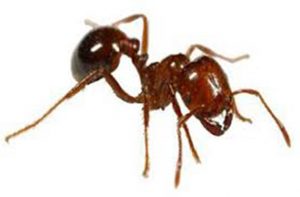ACOUSHI drugger or leaf-cutting ants are major pests wherever they occur. They can, therefore, be considered as general insect pests and are usually rated as the most destructive insect in the Americas, the only region where they occur. They are familiarly known in Guyana as leaf-cutting, fungus growing and mound-building ants. They are highly polyphagous i.e. destroying most crop species.
The plant material that they cut is not utilised directly as food, rather, it is used as a substrate for a fungus which the ants cultivate and consume. The fact that the vegetation is used only as base material for the insect’s food, fungus; it allows them to exploit a wide range of plant species.
CHARACTERISTICS
The colony of acoushi ants is divided into many groups with each group being responsible for a specific activity. Some guard and protect the colony whilst others go out and forage for food. The most important member of the colony is the Queen. She is the only egg-laying member of the colony and is responsible for its continued existence. Only one Queen is found per nest.
BAITING FOR ACOUSHI ANT CONTROL
Baiting is the recommended method of control for acoushi ants. It exploits the insect’s feeding behaviour. Like the vegetation which is cut and carried back to the nests, bait picked up by the ants is taken back to the nest to be used as a substrate for the fungus which is the ants’ only food. Bait consists of a toxicant or poison and a carrier which is usually a material that the insects find attractive. The material must be attractive since this determines the degree of acceptance of the bait by the insects.
The Acoushi ant bait is recommended to control the pineapple ants. This bait must be crushed in the bag to break the pellets into smaller pieces. Before the crushed bait is placed in the field, the area should be weeded so the nests present are exposed. During the rainy weather, the bait should be placed in a glass jar or aluminum foil packets to prevent wetting. Nests which are away from the plant should be disturbed and the bait placed close to, but not in the nests. Ant nests which are on the plant should be disturbed to agitate the ants and the crushed bait placed at the base of the plant. The ants will then take the bait back to their nests where control will occur.
INSECTICIDAL SOLUTIONS
 The nests can also be sprayed with a 0.05 percent Basudin (Diazinon) solution. To mix this concentration add 4 ml (1 soft drink cork) of Basudin 60 EC to 4.5 litres (I gallon) water. This spray solution can be applied to the plant where ant shelters are present and also in other parts of the field The planting material should be treated with a 0.05 percent solution of Basudin or Sevin or 0.1 percent malathion. To prepare the 0.05 percent sevin solution mix 8 g (or about 1/4 ounce) of Sevin 85 WP with 13.5 litres (3 gallons) of water.
The nests can also be sprayed with a 0.05 percent Basudin (Diazinon) solution. To mix this concentration add 4 ml (1 soft drink cork) of Basudin 60 EC to 4.5 litres (I gallon) water. This spray solution can be applied to the plant where ant shelters are present and also in other parts of the field The planting material should be treated with a 0.05 percent solution of Basudin or Sevin or 0.1 percent malathion. To prepare the 0.05 percent sevin solution mix 8 g (or about 1/4 ounce) of Sevin 85 WP with 13.5 litres (3 gallons) of water.
The container used to prepare the above solutions should NEVER be used for any other purpose. It is important that the container NEVER store human or animal food, or clothes be washed in it. WEAR GLOVES DURING THE ENTIRE OPERATION AND DO NOT USE THE CONTAINER FOR HUMAN OR ANIMAL FOOD STORAGE OR WASHING CLOTHES. It is also very important that gloves are used when dipping planting materials such as pineapple slips in the insecticidal solution. This prevents the chemical from entering the pores of the applicator’s skin
ADVANTAGES OF USING BAIT:
1. The active ingredient can be spread sparsely in the environment, leaving the pests’ food-seeking behaviour to concentrate the toxicant to lethal doses.
2. Baits require less critical placement than non-persistent insecticides. Nests also do not necessarily have to be located, thus, baits are cheaper to use than those methods which rely on locating the nest.
3. Baits can be so formulated that their effective life is prolonged under field conditions.
BAIT APPLICATION
For most effective results and safety, the following bait application technique is recommended:
a. Scatter bait along the working trail of nests and around feeding holes
b. Do not handle bait with bare hands.
c. Avoid bait becoming wet. Set bait late afternoon when the ants are most active or use bottles or bamboo troughs to protect the material.
d. Do not use bait in the vicinity of livestock.
PRECAUTIONS
i. Do not store bait for more than three months after the production date (date is stamped on packet).
ii. ii. Use all the bait once the packet has been opened.
iii. iii. Store bait in a cool, dry place. iv. Store bait out of the reach of children.












